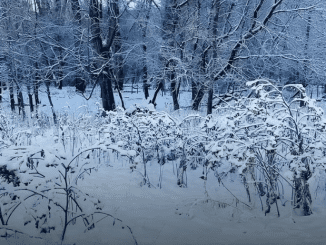In the vast wilderness of the United States, a seemingly innocuous splash of color can hold a dangerous meaning: purple. Across nearly two dozen states, a simple purple marking on a tree or other stationary object serves as a warning to hikers, adventurers, and nature enthusiasts — this is private property, and the landowner may be heavily armed.
These woodsy notations, considered an acceptable substitute for traditional signage in many regions, are the silent sentinels of America’s outdoors. While lawmakers argue that paint markings provide a cost-effective, environmentally-friendly way to denote land ownership, the reality is far more complex and potentially perilous for the unsuspecting trespasser.

Across states like Florida, Texas, Alabama, and South Carolina, the purple paint trend has taken hold as a practical solution to the high costs and maintenance of physical signage. The size and placement of these markings are typically regulated, with guidelines calling for 8-inch long, 1-2 inch wide splotches positioned 3-5 feet from the ground.
Proponents of the purple paint laws believe this method strikes a balance between practicality and environmental preservation, avoiding the unsightly clutter of posted signs. However, critics argue that this approach sacrifices clarity and comprehension for the average outdoor enthusiast.
“The advantage to signage is that anyone who is walking by a boundary can easily read that there’s a private land boundary,” explains Andy Mossey, the stewardship and advocacy coordinator at the Catskill Center. “If it’s just purple paint with no signage, people may be less likely to understand what that is unless the state itself and organizations across the state have done a significant job getting that info across to all visitors.”
The potential for misunderstanding and inadvertent trespassing is a significant concern when it comes to purple paint property markers. Without clear, explicit signage, casual hikers and nature lovers may unwittingly wander onto private land, unaware of the potential consequences.

In states where purple paint is legally enforceable, landowners are granted the right to treat these markings as they would any other “No Trespassing” sign. This means that unsuspecting trespassers could find themselves facing threats, confrontations, or even armed retaliation from property owners who feel their land has been violated.
“If you just use purple paint, can there be fudging?” questions Maria Bedo-Calhoun, president of the Catskill 3500 Club. “It would require strict enforcement in states like New York, where purple paint markings are not legally enforceable ways to denote property lines despite attempts to make it so.”
The use of purple paint markings also raises concerns about the accurate delineation of public and private land. Determining where one ends and the other begins can be an expensive and complex process, leading some to argue that allowing landowners to take matters into their own hands could create further confusion and potential conflicts.
“They clearly stated, ‘Do not access the stream, stay on the trail,'” Bedo-Calhoun continues. “I think the signage is important, knowing that people violate it even with a clear sign.”

For those who do venture into the wilderness, the presence of purple paint markings should serve as a stark and immediate warning: turn back, you are entering private property. Ignoring these signs, whether intentionally or inadvertently, can have serious consequences, including potential confrontations with armed landowners.
The lack of clear, explicit instructions accompanying the purple paint can further compound the danger, as trespassers may be unsure of the proper protocol or the extent of the landowner’s rights. This ambiguity can lead to escalating tensions and potentially volatile situations, putting both parties at risk.
To safely enjoy the great outdoors while respecting private property rights, it is crucial for hikers, adventurers, and nature lovers to familiarize themselves with the laws and regulations surrounding purple paint markings in the regions they plan to visit. Staying informed, exercising caution, and err


